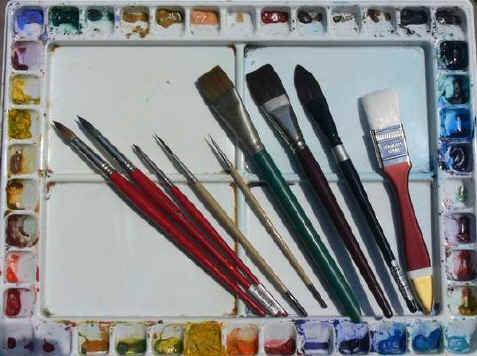|
SUPPLY
LIST
FOR
WATERCOLOR
CLASS

|
This
is my current studio palette (not shown is a white plastic
lid). It has more paint-wells than you may need (20 wells
would work) and an expanded color selection.
In the upper left
corner and coming down the left side are transparent / non-staining colors. Bottom left:
semi-transparent colors. Bottom semi-opaque and opaque colors.
Right-side: Transparent / Staining. Upper-side: earth colors.
Brushes from left to
right: #12 round, sable; #12 round, Synthetic (Notice that the
natural, sable is fatter at the ferrule and will hold more water,
the sharper point of the synthetic indicates a very strong spring
quality.); #6 round, #3 Rigger, #0 round, 1" Aquarelle, 1"
flat, 3/4" filbert (cat's tongue); 1" flat
"Skybrush" |
|
Supplies:
These are strongly suggested, but some substitutions are permissible.
Materials will discussed in detail at the first session. Continuing
students are encouraged to bring supplies for evaluation and comparison.
New students may purchase supplies ahead of time or wait for more informed
consumer information. Most supplies should be purchased from an Art Supply
Store, an Art supply Catalog, or ordered on-line (search: art supplies or
watercolor supplies or use the Supplier's Link
Page).
- A
large flat, rectangular, covered palette with storage wells and
mixing area
- Paper towels
and cloth towel. I recommend a paper towel in your free hand
and the cloth towel in your lap.
- Large
mouth water container (some artists prefer two containers)
- A
sketchbook for drawing and notes
- #2
pencils
- Large
Manila envelope (Fill this envelope with photographs --
magazine photos, post cards, calendar photos, snap shots -- that you
would like to paint. Use this collection of ideas to plan projects
that interest you for the class and beyond. This is important, because
having available ideas is really the hardest part of creating art.
- Paper:
3 sheets of d’Arches, 140 lb., cold press (30" x 22")
These pages can be cut or torn (preferred: folding and using a
straight edge) into quarter sheets (11" x 15"). Arches or
d’Arches may be purchased in 11" x 14" tablet. This brand
is very good for most techniques, other brands tend to be better for
one technique or another. Many brands that are offered in tablets
(spiral or taped) are surfaced sized, wood pulp-based and will not accept multiple
glazes without lifting or mixing with the underpainting.
- Brushes:
Should naturally point or chisel when wet. Most painters look for a
combination of absorbency (an ability to hold lots of water) and
spring (the ability to bounce back to the original shape, the opposite
of limp). The following selection is very minimal and is just a guide.
Brushes are very personal and most artists have several, partially
because they continue searching for the perfect brush. Good brushes
are not cheap.
- #8
round – soft hair, good fine point (a combination of natural and
synthetic hairs creates a good, economical brush that points,
absorbs, and springs.)
- #0 – round
or small liner or rigger. (Combination/blend of natural hairs and
synthetic hair offer the best, economical brush.)
- 1"
flat – chiseled edge. (Combination/blend hairs, see above)
- Paints:
Tube paints are versatile and vibrant, and can be purchased in a
variety of sizes and qualities. (Better paints are more concentrated
and use genuine pigments. They also tend to be more expensive. If
financially possible, buy professional grades and avoid colors
that indicate that they are a “hue” of a color, i.e. Cadmium Red
Light and Cadmium Red Light Hue are not the same pigments and
therefore have different working properties. Professional grade paints
are more concentrated and more vibrant. Student (academy) grade paints
may have fillers, hue-colors, less concentration and less
light-fastness..
Watercolors have
different working properties, I have broken them into categories for
future discussion. While this listing may seem complicated, it quickly
becomes second nature. Other colors may be used; however, this is an
example of a good light permanent palette.
- Transparent
and Semi-transparent / Non-staining Colors:
- Aureolin:
A bright, clear lemony yellow
- New
Gamboge: A clear, golden yellow
- Rose
Madder or Permanent Rose: A clear, cool red
- Cobalt
Blue: A clear blue, slight leaning toward green
- Raw
Sienna: A clear, earthy yellow
- Burnt
Sienna: A clear, earthy red-orange
- Opaques and
Semi-Opaques:
- Cadmium
Red Light: A red that leans toward orange
- Cerulean
Blue: A blue, leans toward green
- Ultramarine
Blue: A blue, leans toward violet
- Transparent
/ Staining Colors:
- Alizarin
Crimson or Acra-Crimson: Strong, cool, clear red
- Thalo
Blue: Strong, cool, clear green leaning to blue
- Thalo
Green: Strong, cold, clear green
- Yellow
Ochre: A cool, neutral yellow
- Burnt
Umber: A warm, dark brown
|
|